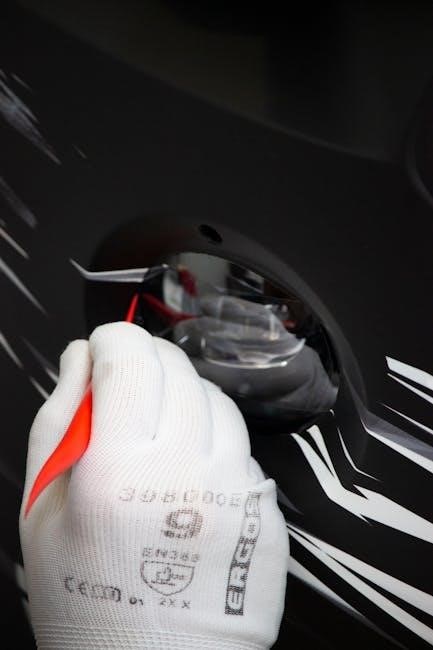The XNX Universal Transmitter is a versatile, hazardous-area-certified device designed for gas detection and monitoring. It offers flexibility, reliability, and advanced features for industrial applications worldwide.
1.1 Overview of the XNX Universal Transmitter
The XNX Universal Transmitter is a highly versatile and reliable device designed for gas detection and monitoring in hazardous environments. It offers advanced features, flexibility, and robust construction, making it suitable for various industrial applications. The transmitter supports multiple sensor types, providing accurate gas detection and monitoring. Its design ensures compliance with intrinsic safety and explosion-proof requirements, while its mounting options and wiring flexibility simplify installation. The XNX Universal Transmitter is widely used in industries such as oil, chemical, and petrochemical sectors.
1.2 Importance of the Installation Manual
The installation manual is crucial for ensuring the safe and proper setup of the XNX Universal Transmitter. It provides detailed instructions, warnings, and cautions to guide users through the installation process. Adhering to the manual is essential for compliance with safety standards and explosion-proof requirements. Proper installation ensures accurate gas detection, optimal performance, and longevity of the device. Failure to follow the manual may lead to hazards or system malfunctions. Always read and understand the manual before proceeding with installation or operation.

Safety Information and General Guidelines
Adhering to safety guidelines ensures proper installation and operation of the XNX Universal Transmitter. Always follow warnings, cautions, and intrinsic safety protocols to prevent hazards.
2.1 Warnings and Cautions
Always read and understand this manual before installing or operating the XNX Universal Transmitter. Ensure the sensor is properly earthed/grounded for intrinsic safety. Never open the transmitter enclosure under power unless the area is confirmed non-hazardous. Follow all safety protocols to avoid risks. Improper installation or operation can lead to system failure or safety hazards. Adhere to explosion-proof and intrinsic safety requirements. Compliance with ATEX and CSA standards is essential. Ignoring warnings may result in serious injury or equipment damage.
2.2 Intrinsic Safety and Explosion-Proof Requirements
The XNX Universal Transmitter meets ATEX and CSA standards for hazardous locations, ensuring intrinsic safety and explosion-proof operation. It is certified for Class 1/Class 2 environments, making it suitable for oil, chemical, and other industries. Proper grounding of the sensor is essential to maintain intrinsic safety. Follow all relevant codes and standards during installation to ensure compliance and safe operation in explosive atmospheres. Always verify certifications for specific applications.

Installation Process
The XNX Universal Transmitter offers flexible installation options, including integral mounting tabs for effortless integration. Ensure proper wiring and electrical connections for safe and reliable operation.
3.1 Mounting Options and Methods
The XNX Universal Transmitter provides versatile mounting solutions, including integral mounting tabs for secure attachment to surfaces. These tabs allow for easy installation in various configurations, ensuring stability and adaptability. The transmitter can be fixed directly to walls or other structures, offering flexibility for different industrial setups. Proper alignment and tightening of mounting hardware are essential to ensure reliable operation and safety compliance. Always refer to the manual for specific guidelines.
3.2 Wiring and Electrical Connections
Proper wiring and electrical connections are critical for the safe and reliable operation of the XNX Universal Transmitter. Use the provided threaded ports for secure cable connections, ensuring compliance with intrinsic safety and explosion-proof standards. Follow the manual’s guidelines for power supply, communication cables, and sensor wiring. Verify all connections are tight and correctly routed to prevent interference or damage. Always ground the sensor for intrinsic safety and consult local regulations for specific wiring requirements.

Operating the Transmitter
The XNX Universal Transmitter ensures safe operation in hazardous environments. Follow the manual for initial setup, configuration, and calibration to achieve optimal performance and reliability.
4.1 Initial Setup and Configuration
The XNX Universal Transmitter’s initial setup involves installing and configuring the sensor, setting the gas type, and defining alarm levels. Ensure the sensor is properly earthed for intrinsic safety. Follow the manual’s guidelines to power up the device and perform a visual inspection. Configure communication settings and parameters as required for your application. Proper setup ensures accurate gas detection and reliable operation in hazardous environments. Always refer to the manual for specific instructions.
4.2 Calibration Procedures
Calibration is crucial for ensuring accurate gas detection. Use zero and span gases to adjust the transmitter’s settings. Follow the manual’s step-by-step guide to perform calibration, which typically takes about 45 seconds. Ensure all electrical connections are secure before starting. After calibration, verify the transmitter’s response to confirm proper function. Regular recalibration is recommended to maintain accuracy and reliability in hazardous environments. Always adhere to the manufacturer’s guidelines for optimal performance.

Maintenance and Troubleshooting
Regular maintenance ensures optimal functionality and safety. Inspect sensors, check connections, and clean components. Troubleshooting guides help resolve common issues quickly, minimizing downtime.
5.1 Routine Maintenance Tasks
Routine maintenance is essential for ensuring the XNX Transmitter operates efficiently. Regularly inspect the sensors and connections, clean the transmitter housing, and verify that all electrical connections are secure. Perform diagnostic checks as outlined in the manual to identify potential issues early. Replace worn or damaged components promptly to maintain accuracy and reliability. Always follow proper safety protocols during maintenance to avoid hazards.
5.2 Common Issues and Solutions
Common issues with the XNX Transmitter include sensor drift, faulty electrical connections, and calibration errors. To resolve these, recalibrate the sensor according to the manual, check and tighten all connections, and ensure the transmitter is properly grounded. Additionally, verifying the gas type and range settings can address misconfigurations. Regular maintenance and adhering to troubleshooting guidelines can prevent recurring problems and ensure optimal performance of the device.

Sensor Compatibility and Integration
The XNX Universal Transmitter is compatible with various sensor types, including models like Sensepoint Optima Plus and Searchline Excel. Refer to specific sensor manuals for detailed installation instructions.
6.1 Supported Sensor Types
The XNX Universal Transmitter supports a wide range of sensors, including infrared, catalytic bead, and electrochemical types. It is compatible with models like the Sensepoint Optima Plus, Searchline Excel, and Model 705 HT. These sensors are designed for detecting various gases, ensuring accurate and reliable monitoring. Proper installation and configuration of these sensors are essential for optimal performance. Always refer to the specific sensor’s manual for detailed instructions.
6.2 Referencing Other Manuals for Specific Sensors
For specific sensor models like Sensepoint Optima Plus, Searchline Excel, or Model 705 HT, refer to their respective installation manuals. These documents provide detailed instructions for proper setup, configuration, and calibration. Compatibility and integration with the XNX Universal Transmitter are ensured when following the manufacturer’s guidelines. Always consult the sensor-specific manual to guarantee accurate and reliable operation. This ensures compliance with safety standards and optimal performance.
The XNX Universal Transmitter ensures reliable gas detection and monitoring when properly installed and maintained. Always follow the manual for optimal performance and safety compliance.
7.1 Final Checks and Testing
After completing the installation, perform final checks to ensure the XNX Universal Transmitter operates correctly. Verify all electrical connections, sensor calibration, and alarm settings. Conduct a visual inspection of the mounting and wiring. Test the system under operational conditions to confirm proper gas detection and response. Ensure all safety protocols are met and documented for compliance. This step ensures reliability and safety in hazardous environments.

References
The XNX Universal Transmitter’s technical manual provides comprehensive installation, operation, and maintenance guidelines. Refer to the Honeywell website for additional documentation and resources.
8.1 Technical Manual and Documentation Links
The XNX Universal Transmitter Technical Manual provides detailed instructions for installation, operation, and maintenance. It includes safety protocols, wiring diagrams, and troubleshooting guides. Additional resources, such as sensor-specific manuals for devices like the Sensepoint Optima Plus, are available on the Honeywell website. These documents ensure compliance with intrinsic safety and explosion-proof standards. Refer to the official Honeywell documentation portal for the latest updates and supplementary materials.
Further Reading
For advanced users, additional resources such as supplementary guides, technical bulletins, and case studies are available. These materials provide deeper insights into specialized configurations and troubleshooting.
9.1 Additional Resources for Advanced Users
For advanced users seeking deeper technical insights, supplementary guides, technical bulletins, and case studies are available. These resources cover specialized configurations, troubleshooting, and optimization techniques. Honeywell XNX Transmitter documentation includes detailed application notes and best practices for hazardous environments. Links to official technical manuals and manufacturer support portals provide additional tools for complex installations. These materials are designed to enhance user expertise and ensure optimal performance.

